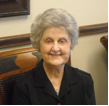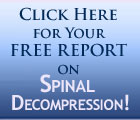STOP Living in Pain Today! • (480) 926-7100 • Call NOW For a FREE ConsultationContact Us
East Valley Spinal Decompression Center
|
|


"I Can Stand and Walk Straight For the First Time in 30 Years"
- Joe A.

"...the greatest gift I have
received in all my life...."
- Joyce B.

"I was unable to bend over enough to dress myself.... My back is completely restored"
- Robert H.

"If it wasn't for the doctor and spinal decompression I would not have been able to continue my job as a meat cutter"
- Leandro M.
Conditions Treated with Spinal Decompression
Click on the following conditions treated by non-surgical Spinal Decompression Therapy treats to learn more:
Herniated or Bulging Discs
Herniation of the nucleus pulposus (HNP) occurs when the nucleus (gel-like substance) breaks through the annulus fibrosis (tire-like structure) of an intervertebral disc (spinal shock absorber). Injury to the disc may result in pain, numbness, tingling or loss of muscle strength. Disc injuries in the neck region may affect the arms or hands while disc injuries in the low back may affect the legs or feet. People between the ages of 30 and 50 appear to be vulnerable because the elasticity of the disc and water content of the nucleus decreases with age.
Back to the top >>
Sciatica (leg pain)
This is a condition which causes pain down the back of one or both thighs. Inflammation of the sciatic nerve (which is the largest nerve in the body-about the diameter of your little finger) can be either constant or intermittent. Success in solving this problem is directly correlated to the diagnosis. Sciatica can be caused by a pinched nerve as it exits the low back spine or it can be caused by prostatic cancer. Odds are usually that the cause is some structural imbalance, but there are so many potential causes, some serious and some benign, it is better to at least know that there may be a grave cause to the symptoms.
This doesn't mean that you shouldn't immediately incorporate a strategy to eliminate any structural imbalances. In most cases, this will resolve the problem. If the problem doesn't respond to these basic efforts, then professional assistance may be needed. The first effort in relieving sciatic symptoms should be to review Hip Pain.
Trigger points can accumulate in the piriformis muscle forcing a contraction and strangulation of the sciatic nerve. The tennis ball exercise should be incorporated to help to relax the piriformis muscle. Stretching may be beneficial, but that is more of a "try an see" exercise.
If there are no improvements with this approach, refer to Low Back Pain to better understand the relationship between the sciatic nerve and the low back spine. Seeking help from a chiropractor or orthopedist may be indicated if the solution can't be found at home.
Back to the top >>
Degenerative Disc Disease (DDD)
Degenerative Disc Disease (DDD) is a natural condition of the body that causes deterioration of the intervertebral discs. This is a gradual process that may compromise the spine. Although DDD is relatively common, its effects are usually not severe enough to warrant significant medical intervention. The intervertebral disc is one structure prone to degenerative changes associated with aging. Long before Degenerative Disc Disease can be seen radiographically, biochemical and histologic (structural) changes occur. Over time the collagen (protein) structure of the annulus fibrosis weakens and may become structurally unstable. Additionally, water and proteoglycans(PG) content decreases. PGs are molecules that attract water. These changes are linked and may lead to the disc's inability to handle mechanical stress.
Back to the top >>
Spinal Stenosis
Spinal stenosis is a condition where the size of the spinal canal is reduced. This may lead to compression of the spinal cord. Symptoms often include pain, numbness, tingling and weakness. Severe cases may actually cause loss of function and may even lead to disability. Spinal stenosis is more common in patients over fifty years of age. Many factors can cause stenosis including injury and degenerative change.
Back to the top >>
How Do I Get Started?
Call Us At:
(480) 926-7100
To schedule an initial consultation with the Doctor nearest you to determine if you are a candidate for care with Spinal Decompression. After carefully studying your case history and exam findings, your Doctor will sit down and determine if you qualify for Spinal Decompression Therapy treatment. If you do qualify for care, your Doctor will explain their recommended plan of action for you. After answering any questions you may have about the recommended plan, you may begin your care.
Treat serious back pain, sciatica, herniated disc, degenerative or bulging disc, or spinal stenosis with non surgical spinal decompression. Learn more about this safe and easy back pain treatment offered by East Valley Spinal Decompression Center and all of our chiropractic services; read testimonials and spinal decompression reviews from many satisfied clients and residents of Gilbert, Mesa, Chandler, Tempe, and Apache Junction, Arizona.

©2008-2010 East Valley Spinal Decompression Center ![]()
![]()
![]()
![]() designed by jeff thomason, ce
designed by jeff thomason, ce
